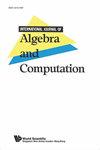On the Number of Tilting Modules Over a Class Of Auslander Algebras
IF 0.5
2区 数学
Q3 MATHEMATICS
International Journal of Algebra and Computation
Pub Date : 2022-05-24
DOI:10.1142/s0218196723500479
引用次数: 0
Abstract
Let $\Lambda$ be a radical square zero algebra of a Dynkin quiver and let $\Gamma$ be the Auslander algebra of $\Lambda$. Then the number of tilting right $\Gamma$-modules is $2^{m-1}$ if $\Lambda$ is of $A_{m}$ type for $m\geq 1$. Otherwise, the number of tilting right $\Gamma$-modules is $2^{m-3}\times14$ if $\Lambda$ is either of $D_{m}$ type for $m\geq 4$ or of $E_{m}$ type for $m=6,7,8$.一类Auslander代数上可倾模的个数
让 $\Lambda$ 是一个Dynkin颤振的零平方代数 $\Gamma$ 是澳洲人的代数 $\Lambda$. 然后是向右倾斜的次数 $\Gamma$-modules is $2^{m-1}$ 如果 $\Lambda$ 是 $A_{m}$ 类型 $m\geq 1$. 否则,数字向右倾斜 $\Gamma$-modules is $2^{m-3}\times14$ 如果 $\Lambda$ 是其中之一 $D_{m}$ 类型 $m\geq 4$ 或 $E_{m}$ 类型 $m=6,7,8$.
本文章由计算机程序翻译,如有差异,请以英文原文为准。
求助全文
约1分钟内获得全文
求助全文
来源期刊
CiteScore
1.20
自引率
12.50%
发文量
66
审稿时长
6-12 weeks
期刊介绍:
The International Journal of Algebra and Computation publishes high quality original research papers in combinatorial, algorithmic and computational aspects of algebra (including combinatorial and geometric group theory and semigroup theory, algorithmic aspects of universal algebra, computational and algorithmic commutative algebra, probabilistic models related to algebraic structures, random algebraic structures), and gives a preference to papers in the areas of mathematics represented by the editorial board.

 求助内容:
求助内容: 应助结果提醒方式:
应助结果提醒方式:


